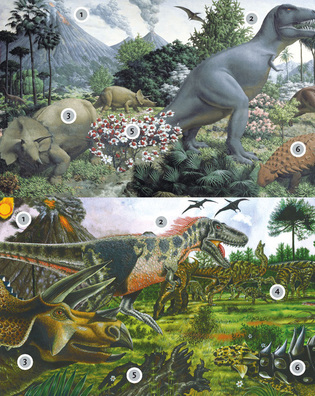 loading
loading
Extreme makeover Top: Rudolph Zallinger ’42BFA, ’71MFA. Bottom: Alan Male.View full image(1) Volcanoes, plus a meteor Scientists in the 1940s believed that an increase in volcanic activity 65 million years ago altered the climate and helped bring about the end of the dinosaurs. While recent research has shown that volcanoes did play some role in the mass extinction, the most important factor was likely a large asteroid or comet that slammed into the planet, throwing huge clouds of dust and gases into the atmosphere. But today we know that some dinosaurs survived, says paleontologist and Peabody curator Jacques Gauthier. "We now just call them birds." (2) Lord of the jungle In both the Peabody's 1947 mural and Alan Male's update for the Yale Alumni Magazine, a fearsome Tyrannosaurus rex lords it over the landscape. But paleontologists now believe the uber-predator was trim and colorful. Alan Male's is most likely a teenager. "Young tyrannosaurs definitely had feathers," says Gauthier, "and these, or some kind of down, lasted at least until adolescence. You see this pattern in elephants -- the juveniles are hairier than the adults. Perhaps it was also true in T. rex. " (3) Triceratops The three horns of Triceratops and the frill behind the animal's head were probably used for defense and helped members of the species to recognize each other. Experts are divided over how quickly Triceratops could move, but they agree that its legs were not splayed to the side, lizard-fashion, as they appear in the Peabody mural. The new posture suggests a less lumbering, more alert beast -- no easy prey for T. rex, notes Gauthier. "Triceratops was a very dynamic animal." (4) Herd behavior Hadrosaurs (or duck-billed dinosaurs) such as Edmontosaurus often traveled in herds made up of animals of different ages and sizes -- think North American buffalo or African wildebeest. These vegetarian dinosaurs had scales rather than feathers. Many had large noses, and some had hollow crests, both of which were probably used to make hooting sounds to call potential mates or alert the herd to danger. "Duckbills may have undergone regular, long-distance migrations to lay their eggs or move in search of food," adds Gauthier. "An Edmontosaurus herd would have had quite an environmental impact." (5) Floral display "T. rex wouldn't have stopped to smell the magnolias," says paleobotanist Leo Hickey. "Springtime in the Cretaceous was not showy." Flowering plants had evolved by then, but many of the flowers of that era were small and inconspicuous, the blossoms typically opening one at a time rather than en masse. Beetles did most of the pollinating. (6) Tanks The ankylosaurs (or tank dinosaurs) were short, stocky, and armor-plated, often in the extreme. To refine the painting's flow of geologic time, paleontologist Daniel Brinkman suggested replacing its Ankylosaurus—a contemporary of T. rex at the end of the Cretaceous, 65 million years ago—with Sauropelta, a relative that lived about 110 million years ago.
|
|